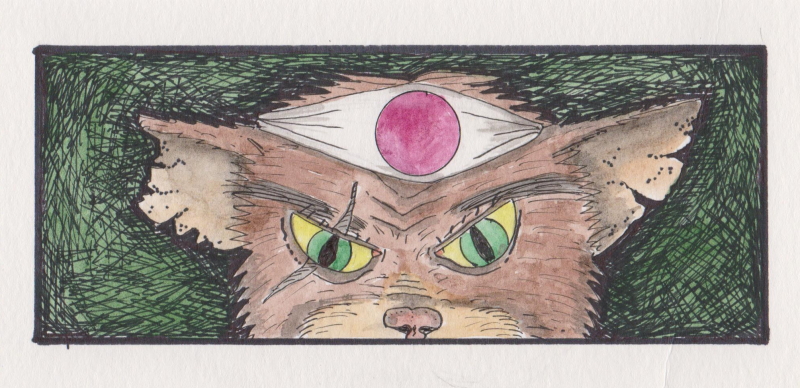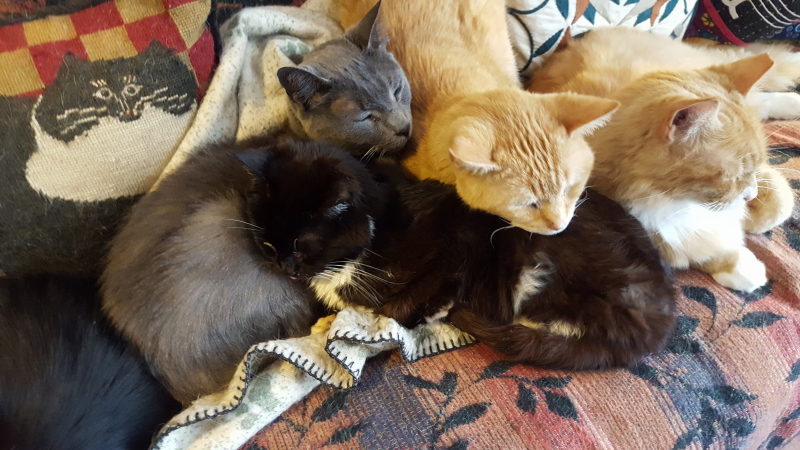
The Mysterious Technique of the Cat
In old Japan there was a swordsman named Shoken, and Shoken had a problem with a rat. Not a cute little rat as you find in pet stores but a extra large, nasty, aggressive, intelligent rat of an excessively ill nature. Shoken had a cat, and in those days cats earned their keep by fighting the rats, mice, weasels, and assorted other less desirable creatures that came around the houses.
Unfortunately Shoken’s cat, a skilled fighter in his own right, was easily defeated by the intelligent rat. More cats were brought in, all masters in the Way of the Cat, they too were defeated. Shoken then took matters into his own hands and went after the rat with his bokken, a wooden training sword. After a long fight involving much destruction of the wood and paper walls of Shoken’s house the rat got the better of him by leaping at his face to bite. Shoken beat a hasty retreat.
Shoken had heard of a neighbor, at the other end of his village that had a cat that had never been defeated, and in his desperation sent a man to borrow this fierce feline. The cat was old and rather decrepit looking, it didn’t look capable at all, but Shoken decided to give it a try. The cat was placed in the room with the rat and promptly lay down and just stared at the creature. The rat was overpowered by the cat’s force of will and cowered in a corner, scrabbling around looking for a way out, then the cat struck. One blow with his front paw. The rat was easily and quickly dispatched.
The other cats, gathered around the old Cat and asked with great politeness and bows of respect “Master please teach us your technique”, and the instruction began.
In the practice of kenjitsu, the Way of the Sword in Japanese martial arts, there are many things that you must learn. Two of the most important, though, are to build up your inner force, the chi, (which is essentially changing how you think), and to move decisively and with speed. This is what the Cat taught to the other cats.
Unlike what you see in popular media that often show long involved sword fights with much posturing and ringing noises, real swordsmanship is swift, deadly, and brutally efficient. Fights last seconds not minutes. Mostly, since we rarely fight with swords in modern times, we easily forget that not that long ago swordsmanship was serious business.
We also forget that in the process of learning to fight, we learn when and when not to fight.
Cats still understand this. They also understand some other things.
The Way of the Pile of Cats

The common house cat is one of the most efficient predators on earth but they also know how to get along with each other, mostly, in this respect they are much like us humans, though we tend to easily forget this simple fact. Though they can be fierce and are armed with sharp teeth and claws they can curl up with each other for warmth and comfort or just to be together, they form long lasting bonds with each other, humans, and sometimes with other animals. There is as much to be learned from the Way of the Pile of Cats as there is from The Mysterious Technique of the Cat.
In its purist sense the word samurai literally means “to serve”. Like many good ideas this was often unfortunately perverted for power or political ends. But most well trained samurai understood that their ultimate responsibility was to serve the people, all of them. War is a terrible thing, even more so in medieval Japan, the ability to stop a conflict quickly and decisively was important for all involved whether this involved diplomacy or the swift removal of a head.
The ability to make quick decisions and the skill to implement them preserved the lives of those that couldn’t fight for themselves.
There is a lesson here as well.
To be honest it was a lot more complex in feudal Japan than that, but it is the general idea. Truth in history is important.
The lesson is balance, the yin and yang, light and dark, good and evil, call it what you will, but things need to balance. Too much of any one thing throws everything else off. This leads to unnecessary strife and suffering, and usually those with no voice suffer the most. If you can, speak for those with no voice. Be mindful and compassionate and fear not to fight if need be.
This is the Way of the Pile of Cats.
Note on the Mysterious Technique of the Cat
The Mysterious Technique of the Cat is a very old teaching allegory, much beloved of Japanese teachers of kenjitsu; it is also used in a slightly different form by Chinese sword masters. It is typically written with the story of Shoken and the rat in the beginning and then turns into a question and answer session on technique and philosophy between the Cat and the other cats. Many old texts used in martial arts follow this format. No one really knows who first wrote this allegory but it has been written down many times and is probably hundreds of years old. And, yes, it works.
The copy that I used to write this is in another work titled “The Demon’s Sermon on the Martial Arts” by Issai Chozanshi, a pen name, who was really Niwa Jurozaemon Tadaaki (1659-1741) other than the fact he was a samurai not much is known about this man. The Demon’s Sermon is a rewriting of older works dating back to the late 1100’s AD on Tengu-Geijutsu-Ron, the Mountain Demon Style of swordsmanship taught to Minamoto Yoshitsune (1159-1189, maybe, lots of stories about this guy) by the Tengu, sort of birdman demons who were magnificent swordsmen. The Demon’s Sermon is written in the same manner as the Technique, as a question and answer session between Tengu. This one works too.
The Way of the Pile of Cats is my own idea.
Trent Carbaugh, December 2018
The Demon’s Sermon on the Martial Arts, Issai Chozanshi, translated by William Scott Wilson, Kodansha International, 2006